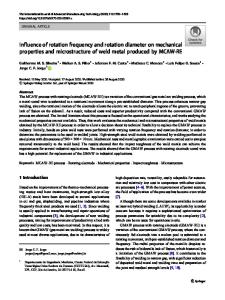Influence of Weld Cooling Rate on Microstructure and Mechanical Properties of Alloy 718 Weldments
- PDF / 1,593,673 Bytes
- 13 Pages / 593.972 x 792 pts Page_size
- 1 Downloads / 439 Views
TRODUCTION
ALLOY 718 is a Ni-base superalloy, particularly developed for medium temperature range aerospace applications due to its excellent mechanical properties coupled with superior corrosion and oxidation resistance.[1] It is strengthened by c¢¢ (Ni3Nb, ordered bct crystal structure) and c¢ (Ni3(TiAl), ordered fcc crystal structure), which are primary and secondary strengthening precipitates, respectively. It contains d and carbide particles. Laves and r phases may also be present in wrought products either due to improper homogenization or as a result of very-long-time service exposures.[1] The Laves phase is an unavoidable terminal solidification phase in alloy 718 and is always present in as-cast microstructures. Many of the aerospace industrial components such as high-pressure compressors, casings, and exhaust cone assemblies, involve joining by fusion welding. Among the available fusion welding processes, gas tungsten arc (GTA) and electron beam (EB) welding are the two most commonly used processes for alloy 718. Although alloy 718 is considered to be better for welding due to its resistance to strain-age cracking among all nickel-base alloys, there are two major concerns in welding of alloy 718: (a) heat-affected zone microfissuring and (b) Nb segregation and Laves formation during weld metal solidification resulting in inferior weld mechanical properties. As-weld fusion zones in alloy 718 are characterized by extensive K. SIVAPRASAD, Lecturer, is with the Department of Metallurgical and Materials Engineering, National Institute of Technology, Tiruchirapalli 620 015, India. Contact e-mail: [email protected] S. GANESH SUNDARA RAMAN, Associate Professor, is with the Department of Metallurgical and Materials Engineering, Indian Institute of Technology Madras, Chennai 600 036, India. Manuscript submitted August 12, 2007. Article published online June 10, 2008 METALLURGICAL AND MATERIALS TRANSACTIONS A
interdendritic Nb segregation and the presence of Laves phase in interdendritic regions. Solidification in alloy 718 starts with a primary Liquid fi c reaction and proceeds, causing enrichment of Nb, Mo, Ti, Si, and C in the interdendritic liquid until a eutectic-type reaction Liquid fi (c + Laves) occurs, terminating the solidification process.[2] Thus, Laves formation in alloy 718 is basically a consequence of interdendritic Nb segregation. Very few investigators have conducted detailed examination of Nb segregation and Laves phase in alloy 718 welds. Alloy 718 GTA weld fusion zones were reported to show large amounts of interdendritic Laves phase in the form of long chains of interconnected particles.[3–5] Knorovsky et al.[2] conducted a detailed microstructural study on alloy 718 GTA as-weld fusion zones. They found that the interdendritic regions became enriched in Nb, Mo, Ti, and Si, while the dendrite core regions were depleted of these elements with higher concentrations of Ni, Cr, and Fe, relative to the base material composition. The c + Laves eutectic was found to be the major interdendritic constituent with a sm
Data Loading...











